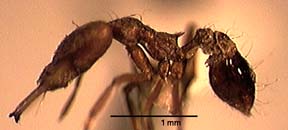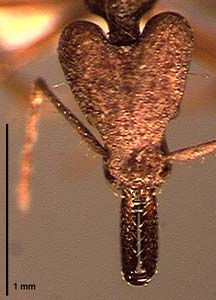Strumigenys precava Brown 1954
Dacetini, Myrmicinae, Formicidae, Hymenoptera, Insecta, Arthropoda, Animalia
John T. Longino, The Evergreen State College, Olympia WA 98505
USA.
longinoj@evergreen.edu
22 April 1997

Specimen: Costa Rica, Prov. Puntarenas: Res. Biol. Carara, 500m (J. Longino 606-s). INBIOCRI001283750. Image by J. Longino.
Identification
Apical fork of mandible with one intercalary tooth, but tooth nearly invisible (see below); mandible with one preapical tooth just proximal to apical fork; sides of head in front of eyes deeply and broadly excavated; gaster smooth and shiny, with long flagelliform setae.
Brown (1954) describes the species as having "intercalary tooth represented by an inconspicuous but acute spur, fused most of its length with the dorsal face of the ventral apical tooth." In the one Costa Rican specimen I have examined, the intercalary tooth is in the position described, but is so reduced that it is barely visible as a slight step, not an acute spur.
Head length 0.87-1.01mm, mandible length 0.50-0.56, CI 71-79, MI 54-61 (n=92 workers from 7 localities; Brown 1962).
Similar species: elongata, consanii.
|

Specimen: Costa Rica, Prov. Puntarenas: Res. Biol. Carara, 500m (J. Longino 606-s). INBIOCRI001283750. Image by J. Longino. |
Range
Costa Rica, Panama, Guyana, Amazonian Bolivia. Costa Rica: Carara.
Natural History
Brown and Wilson (1959) summarize the genus as follows:
"Widespread in tropics and warm temperate areas. Primarily forest-dwelling; some species occur in grassland and arid scrub. ... Nests mostly in soil and rotting wood; a few species live in arboreal plant cavities in tropical rain forest. Foraging hypogaeic to epigaeic-arboreal. Food: most species are collembolan feeders; a few are polyphagous predators or occasionally feed on sugary substances..."
Brown (1962) reported
"I found this species rather common on Barro Colorado Island [Panama] ..., nesting in red- or chocolate-rotten logs. One nest found was very large, containing several hundred - perhaps a thousand or more - workers. Workers were seen carrying a mycetophilid larva and a termite nymph into this nest as it was being opened, and a captive colony fed on a wide variety of small arthropods, including entomobryoid collembolans."
Selected Records
Winkler sample from Carara.
Literature Cited
Brown, W. L., Jr. 1954(1953). The neotropical species of the ant genus Strumigenys Fr. Smith: Group of elongata Roger. Journal of the New York Entomological Society 61:189-200.
Brown, W. L., Jr. 1962. The neotropical species of the ant genus Strumigenys Fr. Smith: Synopsis and keys to the species. Psyche 69:238-267.
Brown, W. L., Jr., Wilson, E. O. 1959. The evolution of the dacetine ants. Quarterly Review of Biology 34:278-294.
 Go back to top
Go back to top

